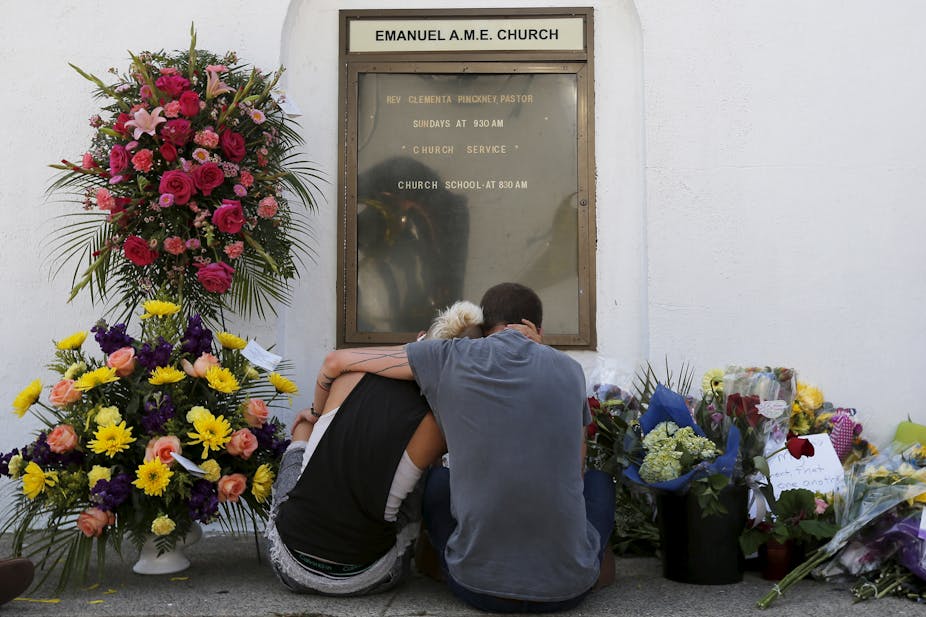Many important things will be said in the next few weeks about the murder of nine people holding a prayer meeting at a historic African American church in Charleston, South Carolina on the evening of June 17.
Here I want to focus on what the suspected killer, Dylann Roof, said right before he gunned down a room full of black worshippers. Reportedly, Roof proclaimed:
“I have to do it. You rape our women and you’re taking over our country. And you have to go.”
It is amazing all that can be said in three little sentences.
To a sociologist who studies gender and its intersection with other forms of inequality, this statement spoke volumes.
Roof’s alleged act was motivated by racism, first and foremost, but also sexism. In particular, a phenomenon called benevolent sexism.
Benevolent sexism
Sociologists use the term “benevolent sexism” to describe the attribution of positive traits to women that, nonetheless, justify their subordination to men.
For example, women may be described as good with people, but this is believed to make them perform poorly in competitive arenas like work, sports or politics. Better that they leave that to the men.
Women are wonderful with children, they say, but this is used to suggest that women should take primary responsibility for unpaid, undervalued domestic work. Better that they let men support them.
And the one that Roof used to rationalize his racist act was: women are beautiful, but their grace makes them fragile. Better that they stand back and let men defend them.
This argument is hundreds of years old, of course.
It’s most clearly articulated in the history of lynching, in which black men were violently murdered routinely by white mobs using the excuse that they had raped a white woman.
Roof is the modern equivalent of this white mob. He believes that he and other white men own me and women like me — “you rape our women,” he said possessively — and so he justified gunning down innocent black people on my behalf. You are vulnerable, he’s whispering to me, let me protect you.
That’s chilling enough, but he also makes claim to the nation itself. “You’re taking over our country” reflects a xenophobic white entitlement to land. We could call it ironic – given the presence of Native Americans centuries before the arrival of the white man – yet it is so routine as to be the common sense of this country.
Colonial attitudes
When European colonizers first arrived on the shores of America, the country was a “she”: they saw “her” as open to discovery and exploration. Today, we still call her the “motherland” and, when she is attacked, we refer to her as the domesticized “homefront.”

In art, too, nations are often portrayed as women, such as in English painter William Blake’s engraving, “Europe supported by Africa and America” (1796) of three naked women – one black, one white, one brown – who stand in for their countries. These white male colonialists hardly differentiated between what could be extracted from the land and their right to extract whatever they wanted from native women.
Roof is that colonizer. White women are his land. His land is a she. His relationship to this country and the white women in it is the same: both belong to white men like him.
In his mind, apparently, black people are the interlopers, the rapists, the plunderers of his natural resources, female and otherwise. It’s a twisted but not an unusual way to think about the world; not then and not now.
As sociologist Michael Kimmel documents in Angry White Men, the rage felt by many rural, poor and working class whites is rooted in the belief that a country that is their birthright is being taken away from them.
A Texas pioneer
In the 1920s and ‘30s, Texan Jessie Daniel Ames was one of the first women to argue that lynching was sexist as well as racist.
She exposed the idea that white women needed protection from black men as a lie, gaining the support of thousands of women and hundreds of public officials for her anti-lynching campaign.
She and other women went into communities where lynchings occurred — where their lives really were at risk from angry white men — and protested the murder of black men with white women’s rape as a justification.
Historian Jacquelyn Dowd Hall describes Ames’s work as a “revolt against chivalry.”
Ames understood that all oppression is interconnected.
We know this now more than ever. We live not in isolated pockets of prejudice, but with a collection of privileges that depend on each other for their persistence and resonance.
Roof’s act was racist, yes, but his racism was built upon colonialism and sexism. Our hierarchies interconnect, interweaving, providing each other with support.
“We are none of us free,” wrote the poet Emma Lazarus, “if we are not all free.”
I am a white woman. I am not yours to protect. No more murder in my name.

